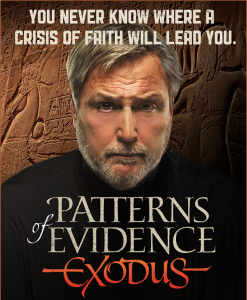It’s been nearly a year since I initially viewed the “Patterns of Evidence: Exodus” documentary, which I briefly reviewed here. It’s now out on DVD and in book form. I watched it first with my family and then with two other OT professors. We all liked it. I think that the video will serve the church and challenge skeptics, for it discloses numerous known archaeological data that support the biblical exodus.
This stated, I want to offer several nagging, overlapping questions that viewers should ask:
- Are there any historical or archaeological data from the 2nd millennium that do not fit the patterns of evidence but that were not mentioned in the film?
- If all the world’s chronology is highly dependent on our understanding of Egyptian history and chronology, how would altering Egypt’s 2nd millennium chronology impact our understanding of known earlier and later events? The impact reaches backward to the timing of Noah’s flood and forward to the dating of key events like the higher influx of the Philistines into Canaan, the period of the judges, the united monarchy, Pharoah Shishak’s attack, and the division of the kingdom.
- The modified chronology views of David Rhol and John Bimson are not new, and Egyptologists have already been responding to them for some time. What counter claims do evangelicals who are resistant to modifying Egypt’s chronology make––both those affirming a 13th century exodus (e.g., James Hoffmeier) and those asserting a 15th century exodus, as the film ably does (e.g., Charles Aling and Bryant Wood)?
- Exodus 12:40–41 states, “The time that the people of Israel lived in Egypt was 430 years. At the end of the 430 years, on that very day, all the hosts of the LORD went out from the land of Egypt.” Most scholars today read this to mean Israel sojourned in Egypt 430 years from the time Jacob entered the land to the exodus. However, the moving up of Egypt’s chronology leads both David Rhol and John Bimson to affirm only a little more than a 200 year Egyptian sojourn for the Israelites. How do the conservatively evangelical filmmakers reconcile the biblical data?
Note on 2 (added 2/29/16): Scripture teaches that the Philistines were already present on Canaan’s western border along the Mediterranean’s eastern sea coast as early as the patriarchs (Gen 21:32, 34; 26:1–18) and the exodus (Exod 23:31). While some have considered these statement anachronisms, I do not see this as necessary. As such, moving up Egyptian chronology would only cause some who discount the early presence of the Philistines to affirm they were indeed there as the Bible states.
Note on 4 (added 2/29/16): Jewish tradition and John Calvin held to a 210 year (not 430 year) sojourn from Jacob to the exodus based on the genealogical data and other specific statements in the biblical text. Supporting biblical data includes but is not limited to the following: (1) The 400 years promised in Genesis 15:13 may well refer not to the length of oppression but to the time until the oppression will cease––about 400 years from the Abrahamic covenant. Indeed, we know the oppression was not 430 years, for Israel lived in solace under Joseph for many years. (2) Paul’s statement that the Law came 430 years after “the promises were made to Abraham” (Gal. 3:16–17) can be read to support a shorter Egyptian sojourn, for his point of departure is the promises to Abraham and the entrance into Egypt by Jacob and his sons. (3) In Acts 13:17–20 Paul states that “all this” from the choosing of the patriarchs through the period of the judges took “about 450” years. If the 450 years indeed refers to everything mentions in vv. 17–20, the actual period from Jacob’s entrance into Egypt to the exodus was not 430 years but much, much shorter. (4) While less specific, Acts 7:17–19 states that already after Joseph’s death but before Egypt actually enslaved the Israelites “the time of the [Genesis 15:13] promise [fulfillment] drew near.” This would be strange to say if there was still many centuries of enslavement ahead, but if the enslavement happened only toward the end of the Egyptian sojourn, Stephen’s stress on the “nearness” of the fulfillment makes more sense. I propose that Moses in Exodus 12:40–41 could be counting from the time when the father of their nation (Abraham) himself first sojourned in Egypt, which happens as early as Genesis 12:10–20 around Abra(ha)m’s seventy-fifth year, soon after his initial entrance into Canaan. The promise of 400 years in Genesis 15:13 is not dated, but came somewhere between Abra(ha)m’s seventy-fifth and eighty-sixth years (Gen 12:4; 16:16).
There is talk that in the spring my school, Bethlehem College & Seminary in Minneapolis, MN, may offer a public showing of the film, followed by a panel discussion. Panelists would include myself, Charles Aling (one of those interviewed in the film who, like me, affirms a 1446 date for the exodus), and Steve Law, co-author of the film commentary and book. If any reader has some further questions that should be raised, let me know.
*****
For a less positive review of the film that raises many of the same questions, see Larry Largent’s post here.
For Mahoney’s response to Largent’s review, search for “Largent” in the extended interview here. The discussion is about half way through the interview.
*****
Update: Bethlehem College & Seminary is sponsoring a free showing this film at the Bethlehem downtown auditorium, Thursday, March 3, 2016, at 7:00 PM. Go here for information and registration.







